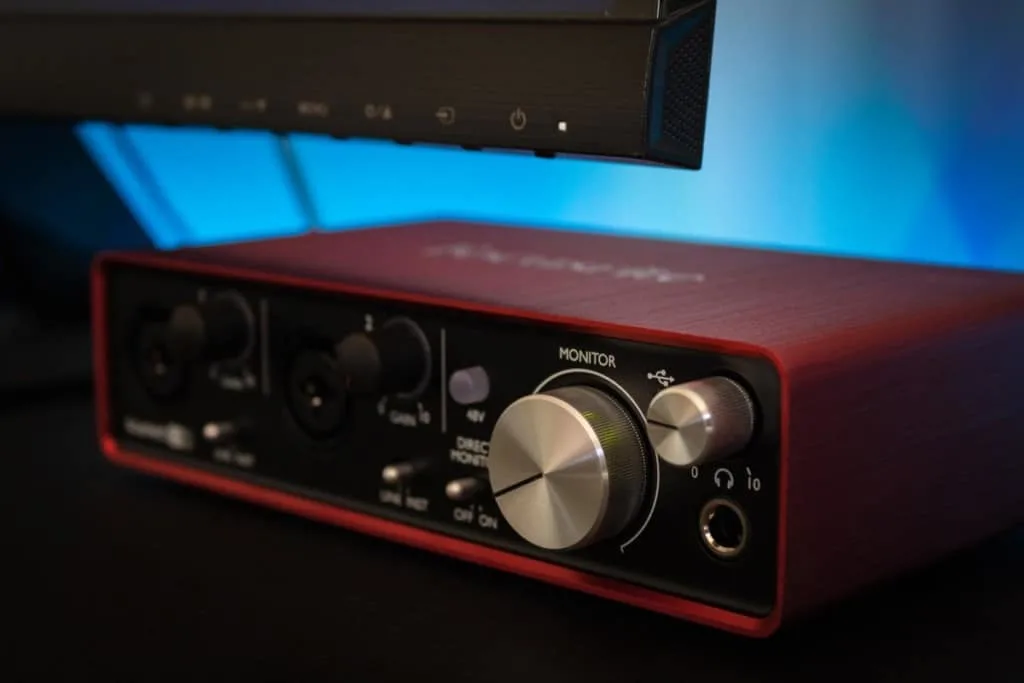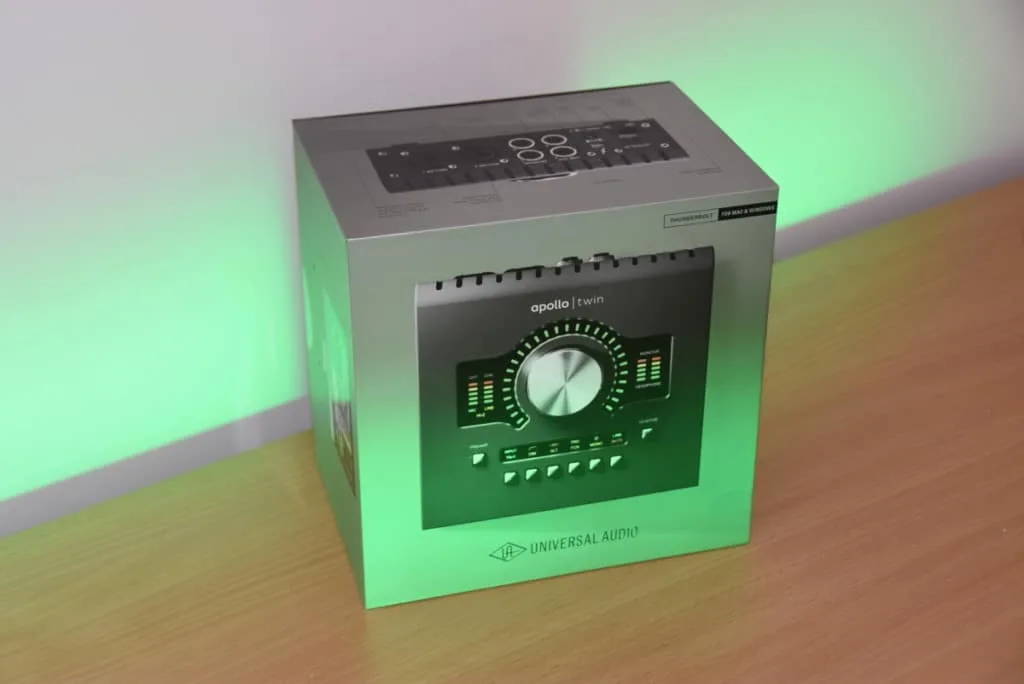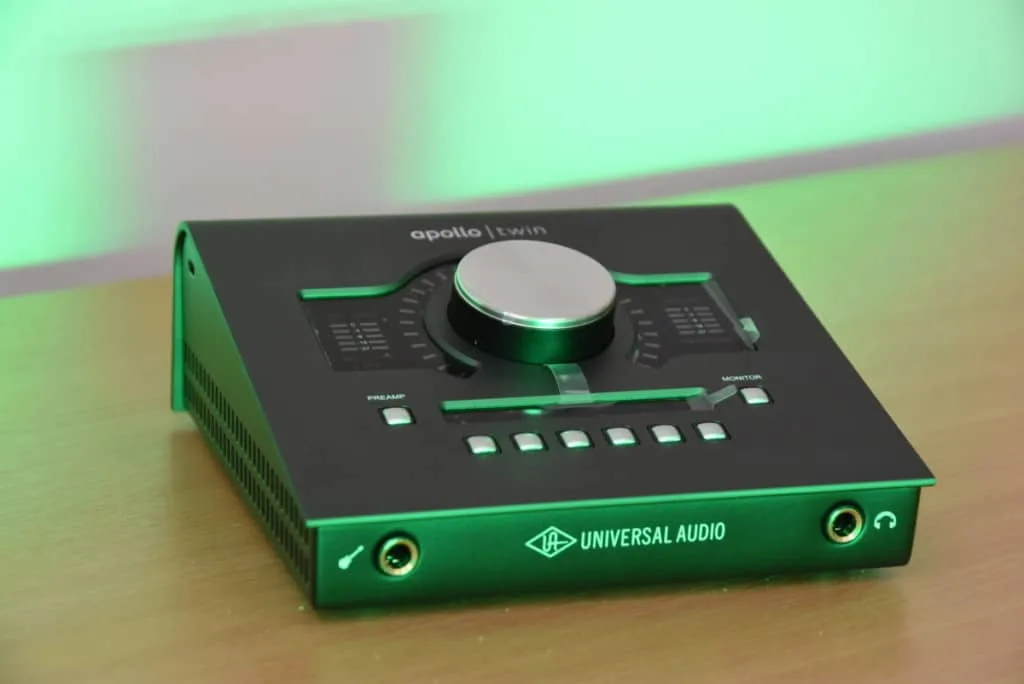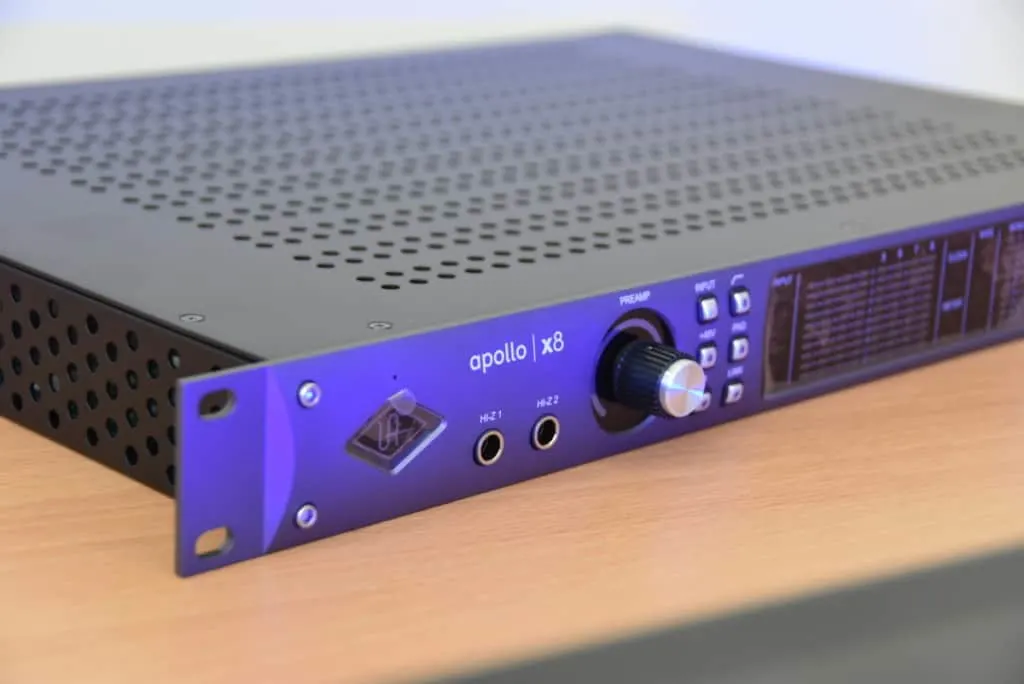When choosing soundcards to build our dream studio PC, we encounter a million different options and that can be a little daunting for most people.
Yes, there are plenty of options, but once you start narrowing them down with some good search criteria; it is possible to choose one that suits your needs perfectly. I have worked with soundcards from the very beginning of my three-decade career and feel I have a thing or two to say about this topic.
So, do soundcards actually make a difference?
Soundcards make a difference in various ways. To begin with, a different soundcard will change the sound of your music creations (for better or for worse). Secondly, a soundcard will also change the quality of the data being processed. Third, a soundcard will lower or increase latency and noise in the signal. Finally, a soundcard will be able to process more or less data at a time giving you the chance to record more instruments at once. Soundcards make a difference, especially in a studio situation.
I will pick my top soundcards later in this article, so once you are armed with the new knowledge this article provides, you can make an informed purchase.
That was the short answer, the tip of the iceberg. Picture me as Morpheus in Matrix, pick the right pill, and come see just how far the rabbit hole goes.
A popular choice of soundcard is the Scarlett Solo 2i2 pictured below. It even comes with free Ableton software. Check out the Scarlett 2i2 here.

Is An Audio Interface A Soundcard?
Soundcards have changed dramatically over recent years, it is important at this point that I answer the question “Is an audio Interface a soundcard”
For a detailed answer please feel free to educate yourself by watching this short video.
Soundcards And Noise, Your Biggest Enemy
Let’s start this by bringing in the figure that all audio people hate the most: Noise.
Coming from where I come from I was able to record my first demos at an early age in my PC´s Audacity software with the integrated soundcard and I can tell you that it was noisy, slow, and… well… overall a terrible, forgettable experience.
I have this vivid memory of the sound of my guitar, and on top of it something that was close to wind blowing; it was as if I had taken the amp outside and recorded the air moving in the backyard.
Noise is, still today, my biggest enemy.
It is the biggest contender to all of us who want to make a living through recording music. Noise will ruin a take, will write “amateur” all over your hard work, and moreover, will turn all your effort into dust with time. I can’t hear that early material today without hurting my ears with just how loud the noises are.
With time I was able to move away from that early PC I had inherited from my mom’s office.
She was a doctor and had recently updated her computer. When I bought my first real audio interface it had the shape of a soundcard too and, being a PC devotee in my early years, I went through several upgrades on the same CPU.
By the time I moved into my first real studio I let go of that Frankenstein I had created and moved on to a MacBook Pro with an external audio interface and that has been the setup up till these days.
Check out this video from the Stampsound Youtube channel for more information.
You can subscribe to the channel here. It’s free!
Some of the things I experienced with low-quality, onboard soundcards were:
I have written an article on recording without an audio interface/soundcard. You can read it here.
Sound Degradation
This is one of the most annoying parts of recording with an onboard soundcard because it kills most of the money you have invested in gear and microphones.
The sound degradation is, in fact, what made me abandon my endeavors with soundcards. The route that the sound takes from and to the motherboard for processing is a vicious circle that takes away most of the best qualities of instruments alike.
For example, the low-end of a tight bass cabinet will come out fluffy while the high-end chime of a pristine acoustic will be shrill and so on.
I have also written a beginner’s guide to help you get started using an audio interface. You can read it here.
Early Soundcards And Latency Problems
This is one of my most vivid memories from starting out.
I remember how I had to guess what I was recording through the latency of what I was playing.
Most of the time I just learned the parts and played them by heart with no monitoring because the latency in audio playback would sound up to two seconds later. Zero-latency is a modern wonder most youngsters don’t appreciate enough; learn to love it because it wasn’t always like that.
Here’s a great video that discusses which soundcard upgrade might apply to your circumstances.
PCIe, (The Thunderbolt for Windows)
After telling you about the hard and winding road that soundcards have been through, it’s time to tell you the good news: PCIe is here to change it all.
This technology avoids the above problems by utilizing specific wiring that mounts the soundcard straight to the motherboard of the PC thus you don’t have latency or sound degradation and can record pristine, amazing audio. As much as Apple users swear by their thunderbolt connections, those who use PCs swear by their PCIe internal connections.
For example, the RME Hammerfall is a great piece of gear that can be installed inside your CPU, and with the simple addition of some accessories, you can plug to it all kinds of microphones and instruments.

Internal Vs External Soundcards For Recording vs Mixing And Mastering
There are two main paths that you can take in the studio: you can be a recording studio or a mixing and mastering studio.
If you choose to be the second, then your requirements are going to change drastically. Also, some musical styles do not require much recording and are more about sampling and digitally emulating. For those case scenarios, I would say that an internal soundcard is just as good as an external audio interface.
When you are doing mixing and mastering you don’t really need to get many things plugged into your soundcard which is one of the Achilles heels of this kind of technology.
In fact, I have done many mixing jobs on PCIe soundcards and the result was superb.
The quality of the processing along with the super-charged CPU made for a very pleasing experience in terms of the final result and also the process to get there.
There is something relaxed about working on a Windows computer that MAC doesn’t have; at least that’s my way of seeing it. So, if you are going to set up a mixing & mastering studio, check out the PCIe options around you.
AD/DA Converters (Showing A Soundcards True Value)
Speaking of soundcards and if do they make a difference, this is the most important aspect of it if you are recording instruments in real-time, including vocals. The AD/DA converters will change what happens when the analog signal reaches digital and vice versa.
This is exactly where a soundcard will show you its true value. The latency you get from soundcards and audio interfaces that cannot handle the amount of data given is impossible to work with in a studio environment.
You simply can’t tell a client that they will hear the playback later and that they have to imagine that they are playing on time with the drummer. Especially not in this day in age!; that will be your first and last ever gig, take my word for it.
The converters in soundcards that only need to reproduce audio or take it in through the computer’s microphone are not built to process the amount of data generated by a DAW and incoming multiple audio sources.
The key is to understand what they are made for. In other words, it is like buying a Vespa and going to a dirt track with it… it’s going to get nasty!
Because of this, soundcards have state of the art AD/DA converters. The more you invest in them, the better the result you’ll have especially for recording audio.

Laptop Or PC? Which Has The Best Soundcard?
This is actually not really a question when it comes to soundcards.
If you are going to build a studio and leave your computer in one place; a PC is a better option because you can always upgrade parts without virtually any downtime from work.
For example, if you were to update the RAM memory or add a hard drive or even upgrade the microprocessor in it; you could just keep the frame, files, plugins, and programs intact.
Moreover, if you were to update continuously the soundcard on it to get better results with a more powerful microprocessor you could do it risking not even one day down.
If I was putting together a studio right now and had a limited budget I would focus on a very powerful PC with an amazing soundcard for mixing and mastering and get an external audio interface to handle recording endeavors.
The Scarlett 2i2 is an excellent choice to get started. Check out the Scarlett 2i2 here.
Internal or External Soundcard? Which Work the Best?
Finally, it is time to discuss the most-addressed controversy in the world of soundcards ever: should you get an internal or an external one? There are pros and cons to both:
· Internal soundcards – The first thing to note about internal soundcards is that they are usually sensibly cheaper and PCIe models are just as fast as Thunderbolt units. On the other hand, they are only useful if you are working in a PC environment rather than a laptop environment because you can’t go in and change it as you could with a desktop PC. Internal soundcards are also more complicated for the connections since they are very likely in the back of your computer and very hard to access. On the other hand, for mixing and mastering, you can get a super capable one at a fraction of a price that you would get an external.
· External soundcards – External soundcards are usually named audio interfaces as well. These are connected via USB or Thunderbolt. On the one hand, they are portable, handy, and easy to use (most are plug and play) and on the other hand, they are more expensive. They are compatible with any and all operating systems and upgrading is even simpler than with soundcards. The connections are usually more at reach in external soundcards, which make them ideal for recording studios that actually cut instruments live.
The PreSonus Audio Box is another popular choice of external USB soundcard. Check out the PreSonus here.
Whichever is the case for you, there will be pros and cons for each approach. If you are starting out and your current computer is a laptop I would say go for it on an external sound card. It is way more important that you get started than getting it perfect from the start.

Other Factors Worth Checking To Improve Studio Sound
If the reason you are reading this article is that you have already started working on your own home studio and you are facing audio issues, then there are several things to bear in mind besides the soundcard.
Acoustic Treatment
The acoustics of places dedicated to sound endeavors is very important. If you are recording music live, you definitely need to get rid of many of the unwanted sounds of poor acoustics.
In fact, most mixing and mastering studios have acoustic treatments for every part of the frequency spectrum.
Once you get rid of all the sound illusions created by your surroundings, your monitors and music will sound better and more accurate than ever. You can find a ton of DIY videos to make your own acoustic panels and save a lot of money.
Here’s just one of those videos.
CPU´s Other Components To Improve Before Upgrading Your Soundcard
Sometimes the lack of RAM memory or a slow microprocessor or even the hard drive of your computer might be affecting its performance and hence, the final results of your recording endeavors.
Before tackling the problem from the sound card, make sure you have a powerful enough machine for what you are doing. Changing the soundcard won’t fix the issue of a slow processor; you might even be loading it with more work.
Make sure every other component in your computer works perfectly well before getting into the soundcard.
Monitors And Headphones
Last but definitely not least is checking if the monitors and headphones are up to the task or not.
Listening through your recycled CD-ready AIWA from 1994 is not exactly a good way to mix a Grammy-Award record. The equipment you should use in a studio dedicated to recording, mixing, or mastering audio has to be professional audio equipment, otherwise, you’ll never hear the nuances of the original audio.
Usually, studio-oriented audio equipment is very boring for music listeners because the EQ curve is almost completely flat (ideally). If you mix in the aforementioned AIWA you’ll fall for the EQ curve and those cool, fat lows will turn into wimpy mids at its best. Make sure your monitors and headphones are studio quality before changing the soundcard.
Check out my article on headphones here.
- A note for gamers
In case you are reading this because you are a gamer, there is a big shout out I have to make to you people.
Gamers need to have a very powerful and capable soundcard if they want to improve their game. Just as much as immersive, closed headphones are needed to have a better gaming experience, soundcards will also allow you to be a step ahead of your competitors.
Things like hearing other people coming your way or finding the way to some part of the game can be drastically enhanced by a good soundcard and a good pair of headphones. Make sure you make your investment there when you buy the ultimate Frankenstein that will take you to the top.
- Here’s to the audiophiles too
This is for all the audiophiles out there who might be reading this to answer the question if it is worth changing the sound card of your computer to hear the music better.
I don’t have to explain what a DAC is to you and how it affects sound quality.
Most DACs don’t accommodate true Hi-Fi equipment because of the impedance; the higher the ohms, the lower the volume. Soundcards that are prepared for this case scenario usually have a headphone preamp attached to it so you can hear at a good volume with maximum quality.
When it comes to speakers, you will very likely need to get yourself an amplifier which will take the signal to the speakers after applying some volume. If the original DAC where they left is of low quality, you would have spent a lot of money on equipment to hear cheap MP3s. That can change with a good soundcard.
Finally, the same thing goes for those who are avid movie fans and want to get their 7.1 in the living room sounding beyond amazing.
Well, if the sound doesn’t come from a good DAC but rather from a stock factory soundcard, you will have spent a lot of money on speakers to hear a watered-down version of the original. A good soundcard can definitely change that for the best.
Ok. As Promised Here’s a list of my favorite soundcards. I have chosen various models and prices to hopefully suit your needs.
- Focusrite Scarlet 2i2
- PreSonus AudioBox USB 96
- Tascam US 16×8
- Audient ID4
- Native Instruments Audio Komplete
- Apollo Twin Duo
- Apollo X16
Final Words On Upgrading Your Soundcard
Changing the soundcard in your computer is always worth it if you are going to invest in something better.
Taking certain precautions like upgrading the rest of the components of the computer as well, treating the room and plugging that computer to good speakers or headphones will take your investment to the next level if that is what you are after.
A good soundcard is the heart and soul of your studio PC, but not the brains. Update your entire rig and invest your budget wisely between RAM, microprocessor, and soundcard and you shall be making a lot of progress.
Happy recording!
